
Food is any substance consumed to provide nutritional support for an organism. Food is usually of plant, animal, or fungal origin, and contains essential nutrients, such as carbohydrates, fats, proteins, vitamins, or minerals. The substance is ingested by an organism and assimilated by the organism's cells to provide energy, maintain life, or stimulate growth. Different species of animals have different feeding behaviours that satisfy the needs of their unique metabolisms, often evolved to fill a specific ecological niche within specific geographical contexts.

Ham is pork from a leg cut that has been preserved by wet or dry curing, with or without smoking. As a processed meat, the term "ham" includes both whole cuts of meat and ones that have been mechanically formed.
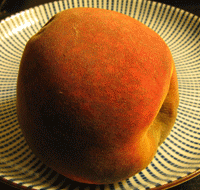
A mold or mould is one of the structures certain fungi can form. The dust-like, colored appearance of molds is due to the formation of spores containing fungal secondary metabolites. The spores are the dispersal units of the fungi. Not all fungi form molds. Some fungi form mushrooms; others grow as single cells and are called microfungi.

Food drying is a method of food preservation in which food is dried. Drying inhibits the growth of bacteria, yeasts, and mold through the removal of water. Dehydration has been used widely for this purpose since ancient times; the earliest known practice is 12,000 B.C. by inhabitants of the modern Middle East and Asia regions. Water is traditionally removed through evaporation by using methods such as air drying, sun drying, smoking or wind drying, although today electric food dehydrators or freeze-drying can be used to speed the drying process and ensure more consistent results.

Jerky is lean trimmed meat that has been cut into strips and dried (dehydrated) to prevent spoilage. Normally, this drying includes the addition of salt to prevent bacteria growth before the meat has finished the dehydrating process. The word "jerky" derives from the Quechua word ch'arki which means "dried, salted meat". All that is needed to produce basic "jerky" is a low-temperature drying method, and salt to inhibit bacterial growth.

Salami is a cured sausage consisting of fermented and air-dried meat, typically pork. Historically, salami was popular among Southern, Eastern, and Central European peasants because it can be stored at room temperature for up to 40 days once cut, supplementing a potentially meager or inconsistent supply of fresh meat. Countries and regions across Europe make their own traditional varieties of salami.

Biltong is a form of dried, cured meat that originated in Southern African countries. Various types of meat are used to produce it, ranging from beef to game meats such as ostrich or kudu. The cut may also vary, either fillets of meat cut into strips following the grain of the muscle, or flat pieces sliced across the grain. It is related to beef jerky in that they are both spiced, dried meats; however, the typical ingredients, taste and production processes may differ.

Tempeh or tempe is a traditional Indonesian food made from fermented soybeans. It is made by a natural culturing and controlled fermentation process that binds soybeans into a cake form. A fungus, Rhizopus oligosporus or Rhizopus oryzae, is used in the fermentation process and is also known as tempeh starter.

Fuet is a Catalan thin, dry-cured, sausage of pork meat in a pork gut. The most famous is made in the comarca (county) of Osona and is also known as Vic fuet. Other places that have long tradition of making it are the city of Olot and the surrounding areas.

Lunch meats—also known as cold cuts, luncheon meats, cooked meats, sliced meats, cold meats, and deli meats—are precooked or cured meats that are sliced and served cold or hot. They are typically served in sandwiches or on a tray. They can be purchased pre-sliced, usually in vacuum packs, or they can be sliced to order.

Beef aging or ageing is a process of preparing beef for consumption by aging it, in order to break down the connective tissue within the meat.
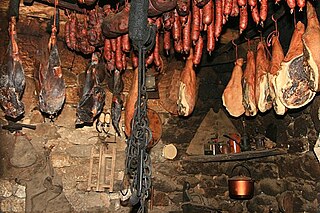
Smoked meat is the result of a method of preparing red meat, white meat, and seafood which originated in the Paleolithic Era. Smoking adds flavor, improves the appearance of meat through the Maillard reaction, and when combined with curing it preserves the meat. When meat is cured then cold-smoked, the smoke adds phenols and other chemicals that have an antimicrobial effect on the meat. Hot smoking has less impact on preservation and is primarily used for taste and to slow-cook the meat. Interest in barbecue and smoking is on the rise worldwide.
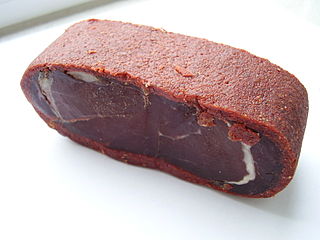
Pastirma or basturma, also called pastarma, pastourma, basdirma, or basterma, is a highly seasoned, air-dried cured beef that is found in the cuisines of Turkey, Armenia, Azerbaijan, Bulgaria, Egypt, and Greece, Iraq and North Macedonia.
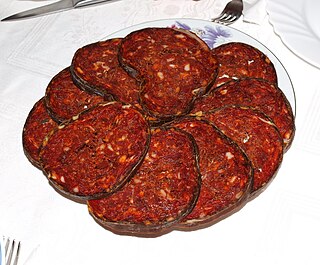
Kulen is a type of flavored sausage made of minced pork that is traditionally produced in Croatia (Slavonia) and Serbia (Vojvodina).
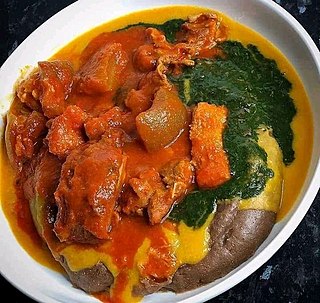
Àmàlà is a local indigenous Yoruba food, native to the Yoruba ethnic group. It is made out of yam and/or cassava flour, or unripe plantain flour. Tubers of Yams are peeled, sliced, cleaned, dried and then blended into flour, it is also called èlùbọ́. Yams are white in colour but turn brown when dried. This gives àmàlà its colour. Àmàlà is consumed by the Yoruba people in Nigeria. Amala is native food to indigenous people of the Southwestern part of Nigeria. It could be served with a variety of ọbẹ (soups), such as ẹ̀fọ́, ilá, ewédú, ogbono, and or gbẹ̀gìrì.

Nigerian cuisine consists of dishes or food items from the hundreds of ethnic groups that comprise Nigeria. Like other West African cuisines, it uses spices and herbs with palm or groundnut oil to create deeply flavored sauces and soups.
The spoilage of meat occurs, if the meat is untreated, in a matter of hours or days and results in the meat becoming unappetizing, poisonous, or infectious. Spoilage is caused by the practically unavoidable infection and subsequent decomposition of meat by bacteria and fungi, which are borne by the animal itself, by the people handling the meat, and by their implements. Meat can be kept edible for a much longer time – though not indefinitely – if proper hygiene is observed during production and processing, and if appropriate food safety, food preservation and food storage procedures are applied.

Food spoilage is the process where a food product becomes unsuitable to ingest by the consumer. The cause of such a process is due to many outside factors as a side-effect of the type of product it is, as well as how the product is packaged and stored. Due to food spoilage, one-third of the world's food produced for the consumption of humans is lost every year. Bacteria and various fungi are the cause of spoilage and can create serious consequences for the consumers, but there are preventive measures that can be taken.

Fermented sausage, or dry sausage, is a type of sausage that is created by salting chopped or ground meat to remove moisture, while allowing beneficial bacteria to break down sugars into flavorful molecules. Bacteria, including Lactobacillus species and Leuconostoc species, break down these sugars to produce lactic acid, which not only affects the flavor of the sausage, but also lowers the pH from 6.0 to 4.5–5.0, preventing the growth of bacteria that could spoil the sausage. These effects are magnified during the drying process, as the salt and acidity are concentrated as moisture is extracted.
Penicillium nalgiovense is an anamorph species of the genus Penicillium with lipolytic and proteolytic activity, which was first isolated from ellischau cheese. This species produces dichlorodiaportin, diaportinol, and diaportinic acid Penicillium nalgiovense is used for the maturation of certain fermented salami varieties and ham. In this process it protects the meat from colonization by other molds and bacteria


















